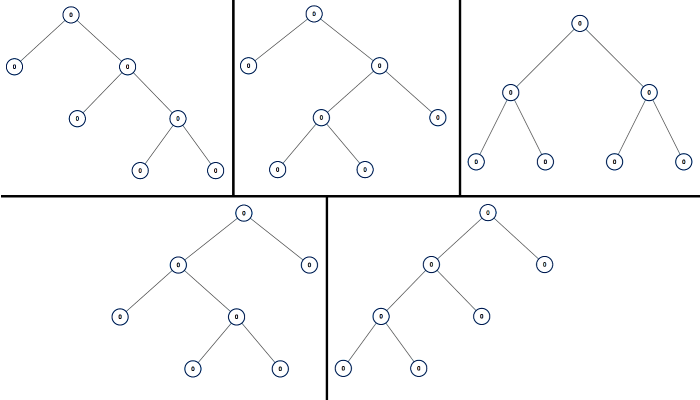QUESTION:
A full binary tree is a binary tree where each node has exactly 0 or 2 children.
Return a list of all possible full binary trees with N nodes. Each element of the answer is the root node of one possible tree.
Each node of each tree in the answer must have node.val = 0.
You may return the final list of trees in any order.
Example 1:
Input: 7
Output: [[0,0,0,null,null,0,0,null,null,0,0],[0,0,0,null,null,0,0,0,0],[0,0,0,0,0,0,0],[0,0,0,0,0,null,null,null,null,0,0],[0,0,0,0,0,null,null,0,0]]
Explanation:

Note:
1 <= N <= 20
EXPLANATION:
首先需要从1往后开始找规律:
1.第一个规律是:偶数肯定不行,因为根节点有一个,其他的节点都是两个,那么就肯定回事奇数。
2.第二个规律是:就是需要两个两个的进行摆放,要不然一个不摆,要不然就是2,于是step就是2.
然后再接着看规律:
N = 1的时候 那么只有一个节点
N = 3 时候,只有一个结果,就是 [0,0,0]
N = 5 时候,有两个结果是[[0,0,0,0,0],[0,0,0,null,null,0,0]] 就是f(5) = f(1+f(3)) + f(f(3)+1)
那么就可以得到规律:
每个数都是 如 7 = (1+f(5)) + (f(5)+1)+ (f(3)+f(3))
得到一个递归的公式。
SOLUTION:
class Solution {
public List<TreeNode> allPossibleFBT(int N) {
if(N % 2 ==0) return new ArrayList<>();
List<TreeNode> res = new ArrayList<>();
if(N == 1) {
res.add(new TreeNode(0));
return res;
}
for(int i = 1; i < N; i += 2) {
List<TreeNode> leftSubTrees = allPossibleFBT(i);
List<TreeNode> rightSubTrees = allPossibleFBT(N - i - 1);
for(TreeNode l : leftSubTrees) {
for(TreeNode r : rightSubTrees) {
TreeNode root = new TreeNode(0);
root.left = l;
root.right = r;
res.add(root);
}
}
}
return res;
}
}